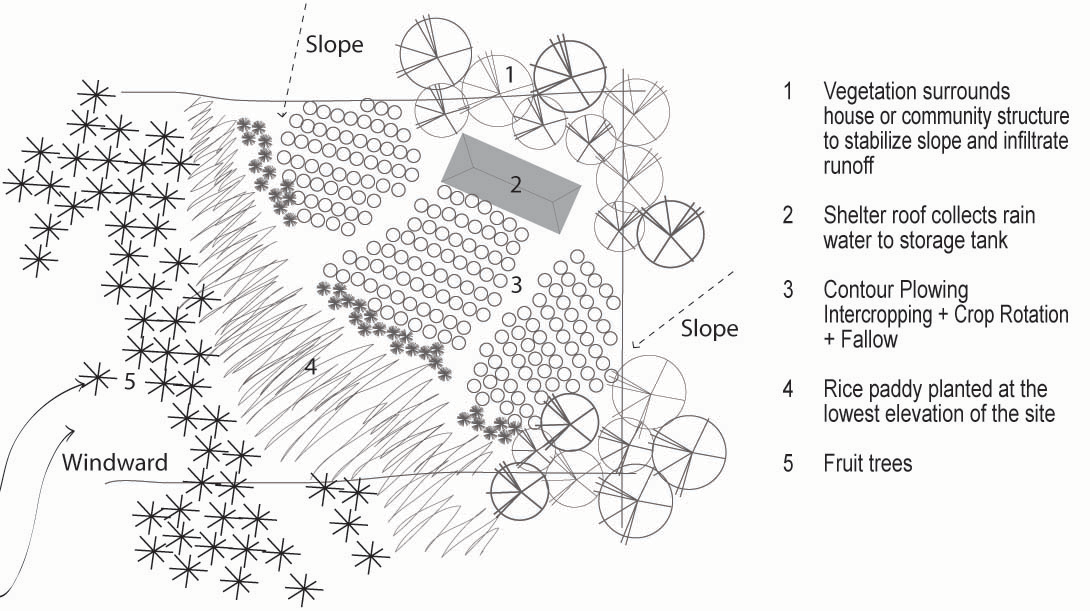
| goals | the garden | the farm | coastal reforestation | resources |

| The Garden |
Initial agroforest plantings contain seed-bearing plants that can wind disperse seeds upland, so planting in rows and allowing forests to infill naturally would be most effective.
There is also the potential to plant agroforests as shelterbelts to create vegetation forms, mimic debris lines, or emphasize topographical features.

Incorporate fruit tree stands adjacent to private and community garden spaces to add vegetative complexity to the site and provide additional resources to complement garden activities and crop production. |
|
| Planting Fruit Tree Stands | |
| Fruit tree stands may be planted in a variety of formations that depend on the relationship between the garden and its immediate context. Planting in clusters establishes a distinct canopy within a stand of trees, as well as support a diverse plant community and habitat. Fruit tree stands adjacent to a private or community garden may provide shade and vegetative buffers between neighboring properties, communities, or other garden spaces. | |
|
|
| Prototypical phasing plan: | |
Phase I [0 - 6 months] : Container planting |
|
Germination and planting of fruit trees in containers to allow mobility and flexibility. |
|
Phase II [6 months – 3 years] : Transplanting into permanent communities |
|
Transplanting container plants into the garden once permanent living spaces have been established. Maintenance of young fruit tree stands and respective garden spaces: |
|
| + Planting | |
| + Harvesting | |
+ Processing/Production activities in conjunction with crop yields from the garden |
|
Phase III [3 - 5 years] : First Harvests |
|
Harvesting from fruit trees depending on growth rate and maturity of trees species and season. |
|
Phase IV and beyond [5+ years] : Full Garden Production: fruit trees, softwoods, and crop yields. |
|
Practice sustainable management methods by balancing fruit tree harvesting periods with garden harvesting and processing activities. Plant a variety of tree species to harvest for a larger variety of fruits, and support year-round management and harvesting activities. |
|
Techniques Soil Long Term: Intercropping and crop rotation should be implemented to maintain soil nutrients. Green mulch helps to build healthier soil and control invasives while enhancing garden productivity. Water Long Term: Effective mulching techniques should be considered to maintain long-term soil moisture. On slopes, more drought tolerant species should be planted uphill and more water-dependent species such as rice should be planted in depressions, valleys, or foothills.
|
|
Planting List Plant low maintenance fruit trees that can be cultivated in low and medium elevations. |
|
Mangifera indica (mangoes) |
The mango tree is erect, 30 to 100 ft (roughly 10-30 m) high, with a broad, rounded canopy which may, with age, attain 100 to 125 ft (30-38 m) in width, or a more upright, oval, relatively slender crown. In deep soil, the taproot descends to a depth of 20 ft (6 in), the profuse, wide-spreading, feeder root system also sends down many anchor roots which penetrate for several feet. The tree is long-lived, some specimens being known to be 300 years old and still fruiting. Will bear fruit in 3 years. |
|
| Annona Muricata (soursop) | |
| Easy to grow in coastal areas and higher elevations. The soursop tree is low-branching and bushy but slender because of its upturned limbs, and reaches a height of 25 or 30 ft (7.5-9 m). Trees will bear fruit in 3-5 years. |
|
| Averrhoa Carambola (starfruit) | |
Small tree that grows in low to medium elevations, if soil is not rich in nutrients, the fruit is not edible. |
|
| Sizygium Aquem Merr & L.M. Perry (jambu air) | |
Low maintenance tree, grows rapidly, attractive tree with white, red, or pink flowers. |
|
Or other native, low maintenance fruit trees that accommodate the needs of individuals or a community. As well as intersperse common native softwoods such as Pinus merkusii as a minor source of wood products for local use. |
|
| [Back to top] |